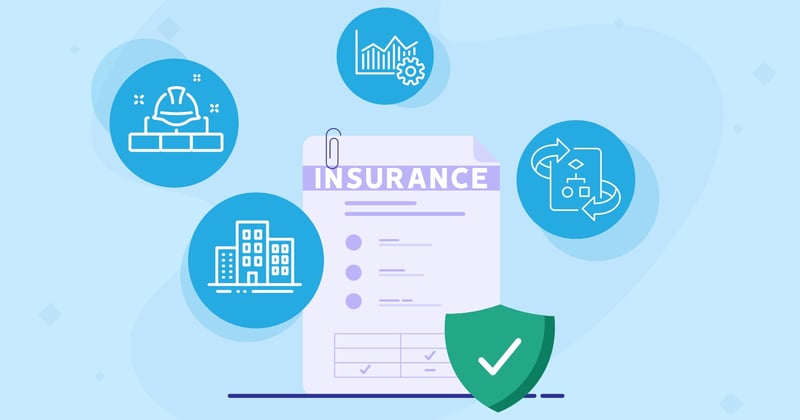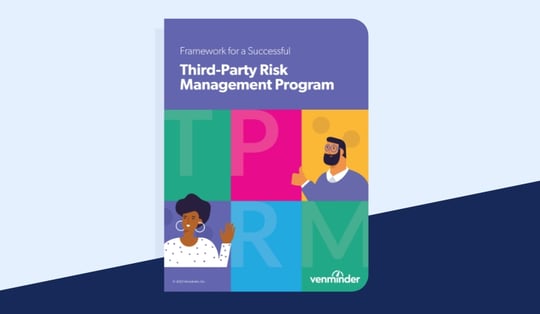Understanding Vendor Risk Management in the Insurance Industry
By: Venminder Experts on August 8 2023
6 min read

In today's interconnected business landscape, insurance companies face many challenges when managing risks associated with third-party vendor relationships. With the increasing reliance on external vendors, insurance companies must implement robust and effective vendor risk management (VRM) practices. Vendor risk management refers to the process of identifying, assessing, and mitigating risks associated with vendors, such as suppliers, outsourcers, and business partners. Implementing vendor risk management practices can help insurers mitigate risk, ensure regulatory compliance, and enhance operational resilience. Vendor risk management can also help insurers safeguard their reputation and gain a competitive edge.
To get started with vendor risk management, it’s crucial that insurance companies understand regulatory requirements and establish a comprehensive VRM framework.
Understanding the Insurance Industry’s Regulatory Requirements
There are many laws, regulations, and industry guidelines governing the insurance industry. Familiarizing yourself with these regulatory requirements is crucial to ensure compliance and avoid potential legal issues. Stay informed about any updates or regulation changes impacting your vendor risk management strategy.
Here’s an overview of the insurance industry’s regulators and advisors:
- State-level regulations: The primary regulator of the insurance industry in the U.S. are the states. The McCarran-Ferguson Act of 1945 gave the states the right to tax and regulate insurance. Statutes and rules differ from state to state. For insurers, this means working with more than 50 different state agencies and hiring state-licensed lawyers.
- Insurance Data Security Model Law: Adopted by many U.S. states, this law requires insurance organizations to implement comprehensive information security programs, including addressing third-party vendor risk.
- Gramm-Leach-Bliley Act (GLBA): Requires financial institutions in the U.S. to protect the privacy and security of customers' non-public personal information. Insurers must implement safeguards to control third-party vendor access to customer information and conduct due diligence on service providers.
- General Data Protection Regulation (GDPR): Applicable to insurance companies operating within the European Union (EU) or processing the personal data of EU residents, GDPR imposes strict requirements on data protection, including conducting impact and risk assessments on third-party vendors and reporting cybersecurity events.
- Health Insurance Portability and Accountability Act (HIPAA): For insurance companies handling protected health information (PHI) in the U.S., HIPAA mandates the implementation of safeguards to protect the confidentiality, integrity, and availability of PHI, including conducting risk assessments and executing agreements with vendors.
- Payment Card Industry Data Security Standard (PCI DSS): If an insurance company handles payment card transactions, PCI DSS outlines security requirements to protect cardholder data, including maintaining secure networks, implementing strong access controls, and regularly testing security systems.
- Sarbanes-Oxley Act (SOX): Although primarily focused on financial reporting, SOX requires insurance companies to establish internal controls and procedures to ensure the accuracy and reliability of financial statements, which may include managing risks associated with vendor relationships.
Five Risks With Third-Party Vendors in the Insurance Industry
Each vendor has inherent risks that need to be identified and mitigated. If your insurance company has inadequate vendor risk management, it can increase costs and lead to financial losses.
Here are five risks associated with using vendors:
- Cybersecurity risks – Insurers use their customer’s personal data to assess risk, set premiums, and develop products and services. This amount of data makes the industry a prime target for cyberattacks. Insurance companies must verify that vendors have implemented safeguards to protect sensitive customer information. Regularly reviewing and updating security protocols to align with emerging threats and evolving regulatory standards is crucial.
- Operational risks – A disruption or failure with a vendor may result in operational downtime, delayed claim processing, or dissatisfied customers. It’s important to ensure that both you and your vendors have plans in place to maintain services during disruptions. Those plans should be assessed and tested regularly.
- Jurisdictional risks – This is the potential risk of engaging vendors located in different legal jurisdictions. There are variations in laws, economic conditions, and political stability across states and countries. Insurance companies should conduct thorough research on laws, regulatory frameworks, and requirements in the specific jurisdiction, seek legal expertise, include contractual protections, monitor legal changes, and consider appropriate insurance coverage.
- Reputational risks – Customers rely on insurance companies to provide everything from car and house coverage to healthcare and business insurance. It only takes one incident, like a data breach or disruption in service, to damage your insurance company’s reputation, even if your vendor was the one at fault.
- Regulatory risks – Insurance companies and their vendors are responsible for complying with state laws and regulations. If your third parties aren’t in compliance, your insurance company could face fines and costly litigation.

Developing a Vendor Risk Management Framework for the Insurance Industry
Establishing a vendor risk management framework is essential for effectively managing vendor risks. This framework should include clear policies, procedures, and governance structures that outline how risks will be identified, assessed, monitored, and mitigated.
Define the roles and responsibilities within your organization to ensure accountability and ownership of the vendor risk management process.
Tip: Effective vendor risk management requires collaboration among internal departments. Engage stakeholders like legal, compliance, and IT teams to establish a cross-functional approach. Each department brings valuable expertise and insights, fostering a shared responsibility for risk management and enabling effective communication and coordination.
Insurance companies should adhere to the vendor risk management lifecycle to ensure the effective management of their vendors.
The lifecycle consists of three key stages: onboarding, ongoing, and offboarding:
- Onboarding – Before you sign the contract with a vendor, it’s crucial that you understand the risk they bring to your insurance company.
- Planning and risk assessment: Insurance companies should identify their need for a vendor and search for potential vendors. This step may involve market research, referrals, requests for proposals (RFPs), or other methods to create a list of potential vendors. Once you’ve identified potential vendors, you’ll need to conduct an inherent risk assessment to determine the types and amounts of risk present in the product or service (and the relationship) and determine if the vendor will be critical to your insurance company.
- Due diligence: Companies should evaluate potential vendors based on various criteria such as capabilities, expertise, pricing, reputation, and compatibility with the organization's requirements. This step can involve:
- Conducting interviews
- Reviewing proposals
- Sending risk questionnaires,
- Conducting site visits
- Checking references
- Collecting documents like the vendor’s SOC report and business continuity testing results
-
- Contracting: This step involves negotiating and finalizing the terms and conditions of the contract. You would set service level agreements (SLAs), key contractual dates, termination clauses, exit plan strategies, etc. Legal and procurement teams usually play a crucial role in this stage.
- Ongoing – Throughout the vendor risk management lifecycle, assessing and mitigating risks associated with vendor engagement is essential.
- Re-assessments: Depending on your vendor’s level of risk, you should re-assess risk periodically. Regular performance reviews, meetings, and reporting should be conducted to ensure the vendor meets expectations.
- Performance and relationship management: This crucial step ensures that your vendor’s quality and risk level is acceptable throughout the relationship. Regular performance reviews, meetings, and reporting are conducted to ensure the vendor meets expectations. To maintain a positive vendor relationship, you should address concerns or issues promptly and foster collaboration. Feedback sessions and relationship-building activities can help strengthen the vendor relationship.
- Due diligence: This is where you’d collect and validate vendor information based on their risk level. You would need to assess and implement controls to mitigate the vendor’s risk.
- Contract renewal: You should review the contract well before the renewal period to make time for potential negotiations. Contract renewals involve re-evaluating vendor performance, negotiating terms for the next contract period, and making any necessary amendments.
- Offboarding – There may come a time when the vendor relationship needs to end. There should always be a termination process in place for any vendor.
- Contract termination: This is where you’d notify the vendor that the contract won’t be renewed after it expires.
- Exit plan execution: Follow the exit plan set in the contract to ensure the vendor returns or disposes of your insurance company’s data. You would also need to revoke the vendor’s system and facility access.
- TPRM closure: After completing the exit plan, there may be a few final steps to close the relationship, like reviewing and paying final invoices.
By following these steps, insurance companies can effectively manage their vendors, mitigate risks, and maintain a productive and beneficial relationship throughout the lifecycle.
Insurance companies need to adopt a proactive approach in managing third-party vendors’ risks. A comprehensive vendor risk management framework is crucial to successfully address risks. By implementing effective vendor risk management practices, insurance companies can enhance their resilience and secure long-term success.
Related Posts
How Insurers Can Mitigate Third-Party Jurisdictional Risk
Third-party vendors are vital to many insurance operations. However, engaging with third parties...
Third-Party Risk Management Strategies Insurance BPO Vendors
In today's fast-paced business world, insurance companies often rely on business process...
Third-Party Risk Management in Healthcare: A Quick Overview
Today’s healthcare organizations rely heavily on third-party vendors for services, such as medical...
Subscribe to Venminder
Get expert insights straight to your inbox.
Ready to Get Started?
Schedule a personalized solution demonstration to see if Venminder is a fit for you.
















